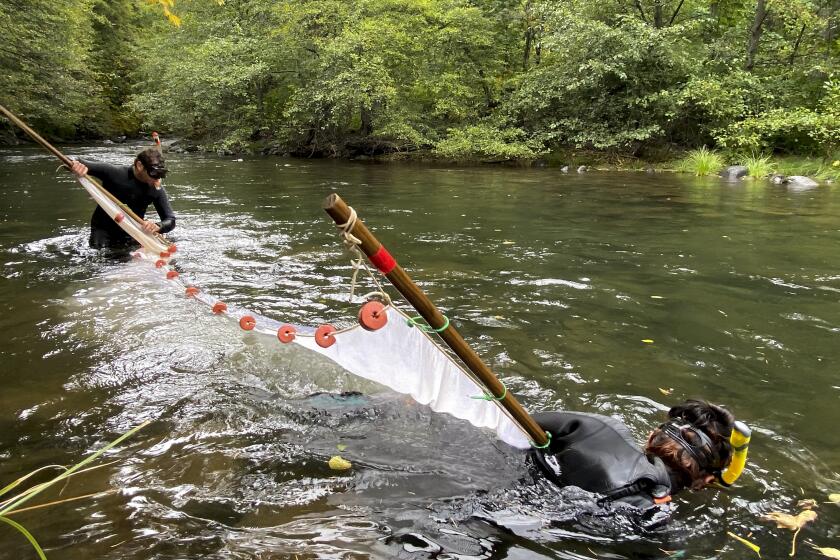Group Launches Bid to Preserve O.C. Open Space
Launching a campaign to preserve vast interior stretches of Rancho Mission Viejo, a consortium of environmentalists, biologists and elected officials Wednesday said the area contains the last, best stretches of certain unique habitats and species.
The Rancho Mission Viejo Co. recently rolled out plans to build 14,000 homes on the 23,000-acre ranch located in southern Orange County, and to preserve 14,000 acres there. The sprawling ranch stretches roughly between San Juan Capistrano and the Cleveland National Forest.
But conservation biologists commissioned by the Endangered Habitats League said in a report presented Wednesday that four core biological areas on the ranch are in such pristine condition that they should be preserved at all costs, including buying them if necessary.
“This is the heart and soul of . . . one of the most intact biological areas in Southern California,” said Dan Silver, head of the Los Angeles-based league.
Wayne Spencer, lead author of the report, said data provided by Rancho Mission Viejo consulting biologists and others showed the core areas include more than half of the world’s remaining population of rare cactus wrens, the nation’s largest contiguous population of the threatened gnatcatcher, portions of the last undammed creek in Southern California, and a tremendous diversity of hawks, golden eagles, mountain lions and other species that require large contiguous wild lands to survive.
“Most Americans think of the Amazonian rain forest” when they think of species going extinct, said Spencer, of Conservation Biology Institute, a nonprofit research institute based in Oregon and San Diego. “Here in Southern California, we’re sitting in one of these globally unique hot spots as well. . . . If we don’t protect this from the degradation of large urban sprawl, we will lose these remaining resources.”
A ranch spokeswoman disputed the findings, noting that the biologists had not done detailed field surveys of the ranch.
“To call Rancho Mission Viejo a pristine wilderness area is simply incorrect,” said Diane Gaynor. “This is an area that has been in active use for 120 years, whether it be mining operations, research and development or agricultural use; at one time the ranch had the largest wheat fields in Orange County.”
She added, “The goal of the family has always been to create a comprehensive land use management and open space preservation plan. The word comprehensive is important, because the opposite would be the piecemeal development.”
As for using the biological core areas as the foundation to determine where to build or not build, Gaynor said, “We don’t have the luxury of looking at our land. . . . and saying how can we address just one issue. . . . We have to look at a multitude of different issues. One: continuing ranching and farming. Two, preserving open space and habitat. And three, meeting needs in this county for homes and jobs.”
She cited a Cal State Fullerton study showing that 22,000 homes were needed in the Rancho Mission Viejo area because of expected population growth.
Spencer said he had been allowed to “briefly review” the company’s development plans, which have not yet been formally filed. He said that review convinced him and his fellow conservation biologists there was a “very large difference” between the company’s planned preservation areas and the unique biological areas the report identified.
“What I remember clearly was many scattered development ‘bubbles’ in the middle of these areas . . . with roads, power lines and sewer lines.”
Spencer said putting such development in the middle of the areas of highest biological diversity would fragment the largely unbroken expanses of habitat that have allowed the area to remain so intact.
He said the land is one of five key remaining areas in Southern California that contain large populations of endangered and threatened species. The others include land in central and northern Orange County and San Diego County.
Wednesday’s news conference and the report essentially kicked off a public education and lobbying effort to counteract a similar public outreach effort being undertaken by ranch officials. Ranch staff members have been meeting with selected groups and soliciting their feedback on possible plans.
Both sides agree that the state’s Natural Communities Conservation Plan process, which allows the destruction of rare habitat and species in exchange for setting aside other fragile lands, is the key to finding a solution.
Ranch officials met with federal and county officials Wednesday to discuss the planning process, Gaynor said. But the environmentalists said it is moving too slowly, and taking place behind closed doors.
Begun in 1991, the southern sub-region Orange County conservation plan is incomplete, although developments originally intended to be part of the area already have gone forward.
Gaynor said the economic downturn of the early 1990s had stalled costly, required biological studies, but that the process was moving forward again.
Federal and county officials agreed that the process is back on track, albeit in the “early stages,” said Jane Hendron, spokeswoman for the Carlsbad office of the U.S. Fish and Wildlife Service.
Other speakers at the news conference included city council members from San Juan Capistrano and San Clemente and Joan Irvine Smith, onetime heiress of the Irvine Ranch who has become involved in environmental causes.
Smith drew the loudest applause from those in attendance when she said she has asked the owners of Rancho Mission Viejo if they want to be remembered for “a lot of ticky-tacky development, or something that can be a wonderful resource for future generations.”
Gaynor responded Wednesday that Rancho Mission Viejo already has contributed 9,000 acres of open space since the 1950s.
More to Read
Start your day right
Sign up for Essential California for news, features and recommendations from the L.A. Times and beyond in your inbox six days a week.
You may occasionally receive promotional content from the Los Angeles Times.






